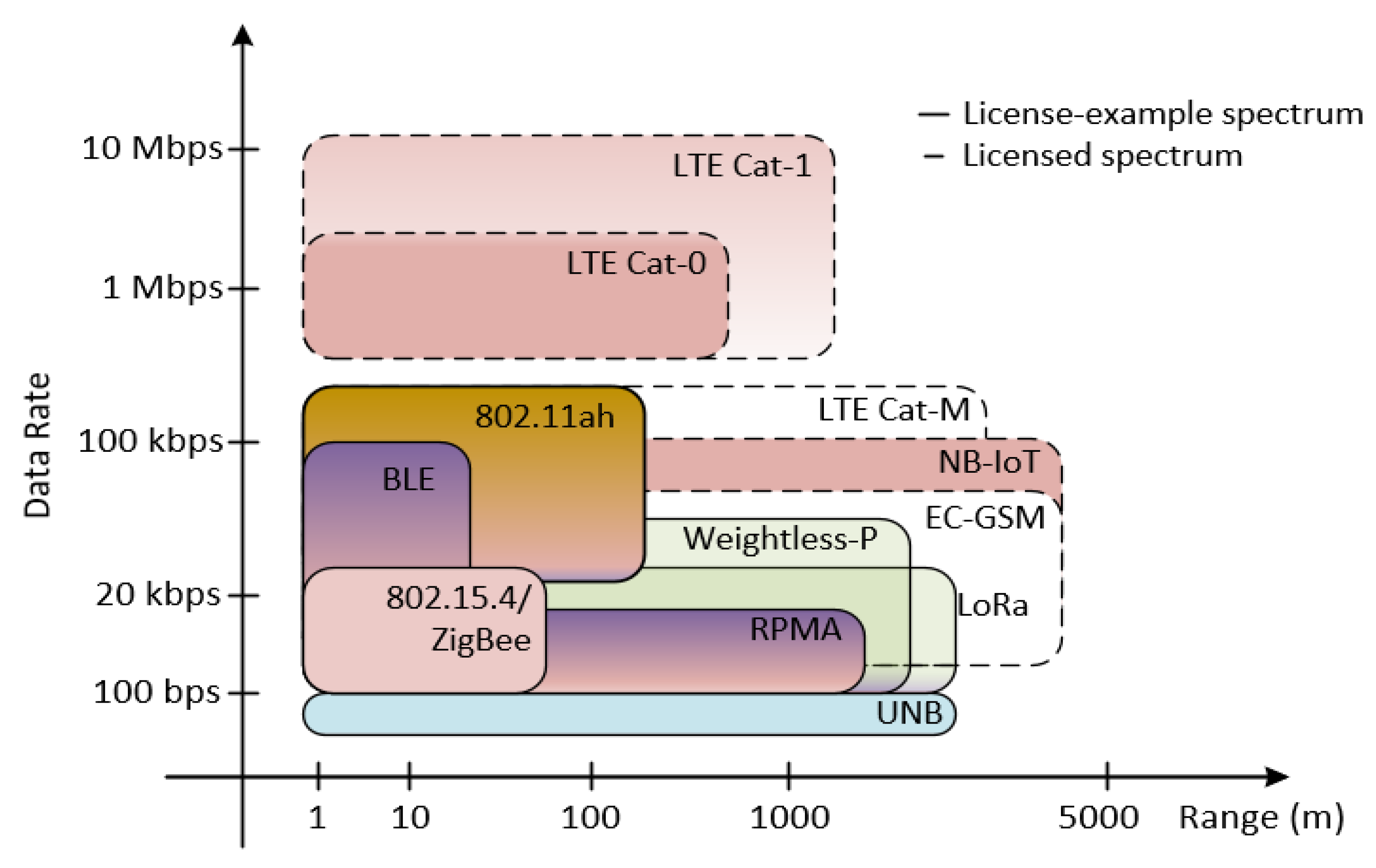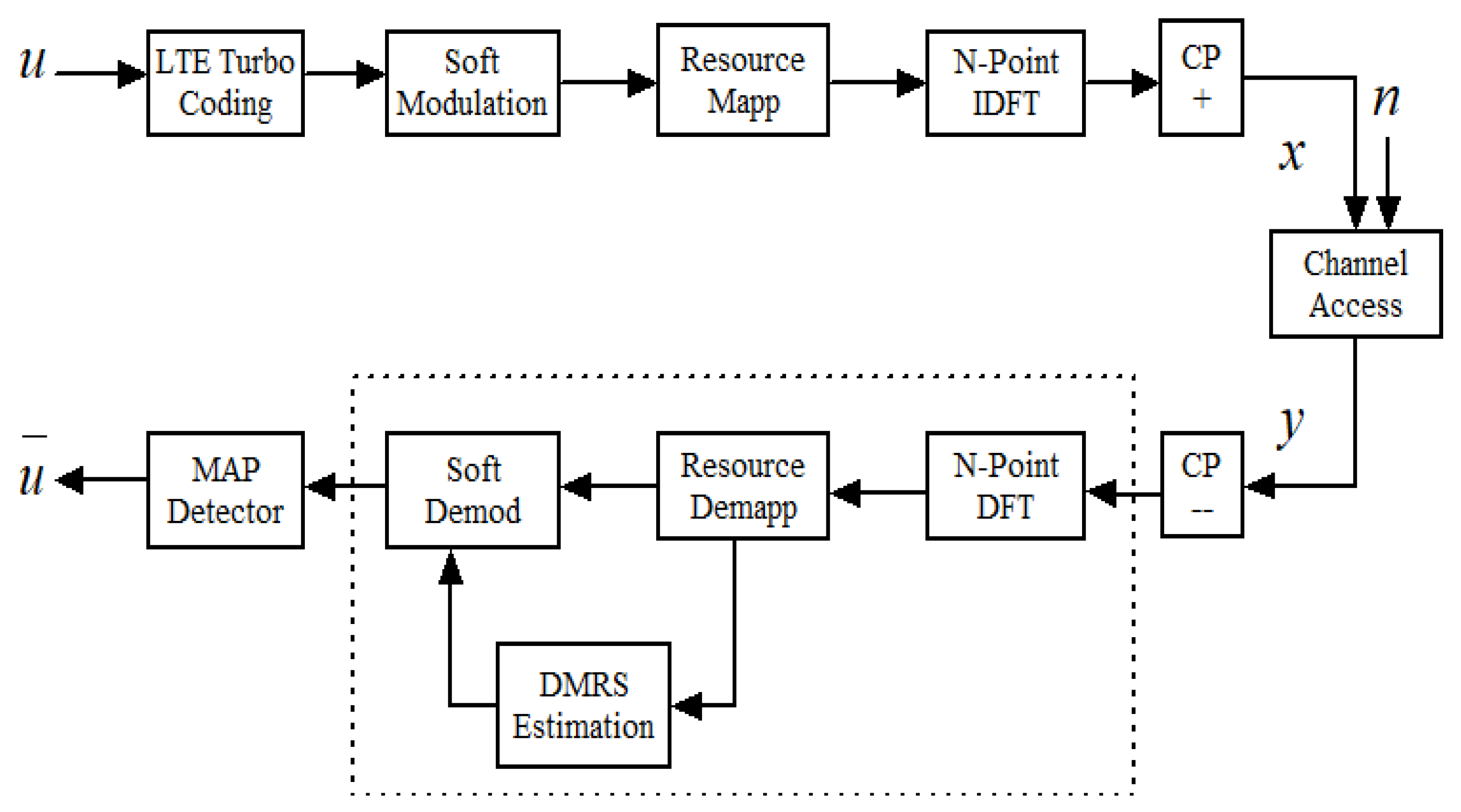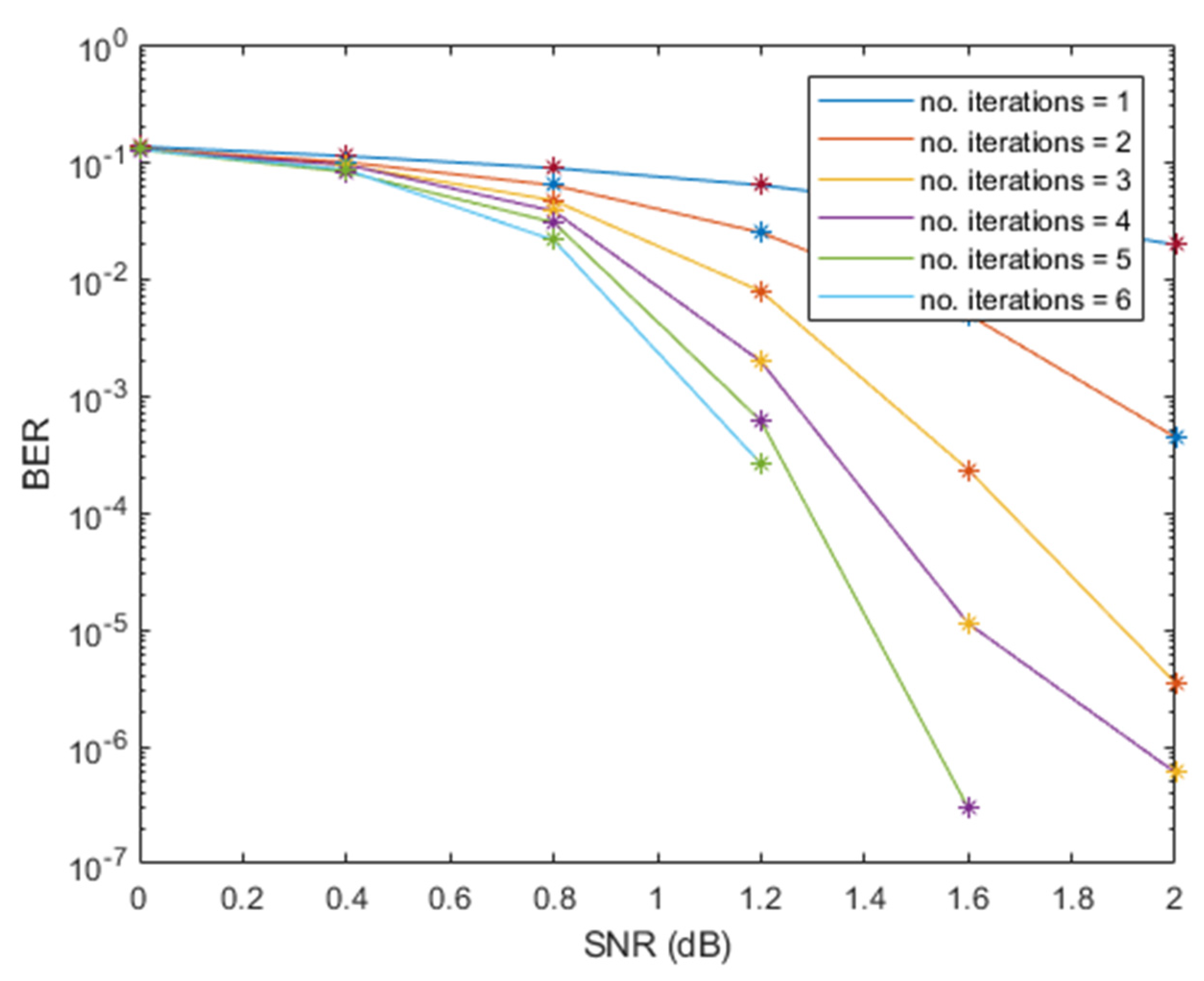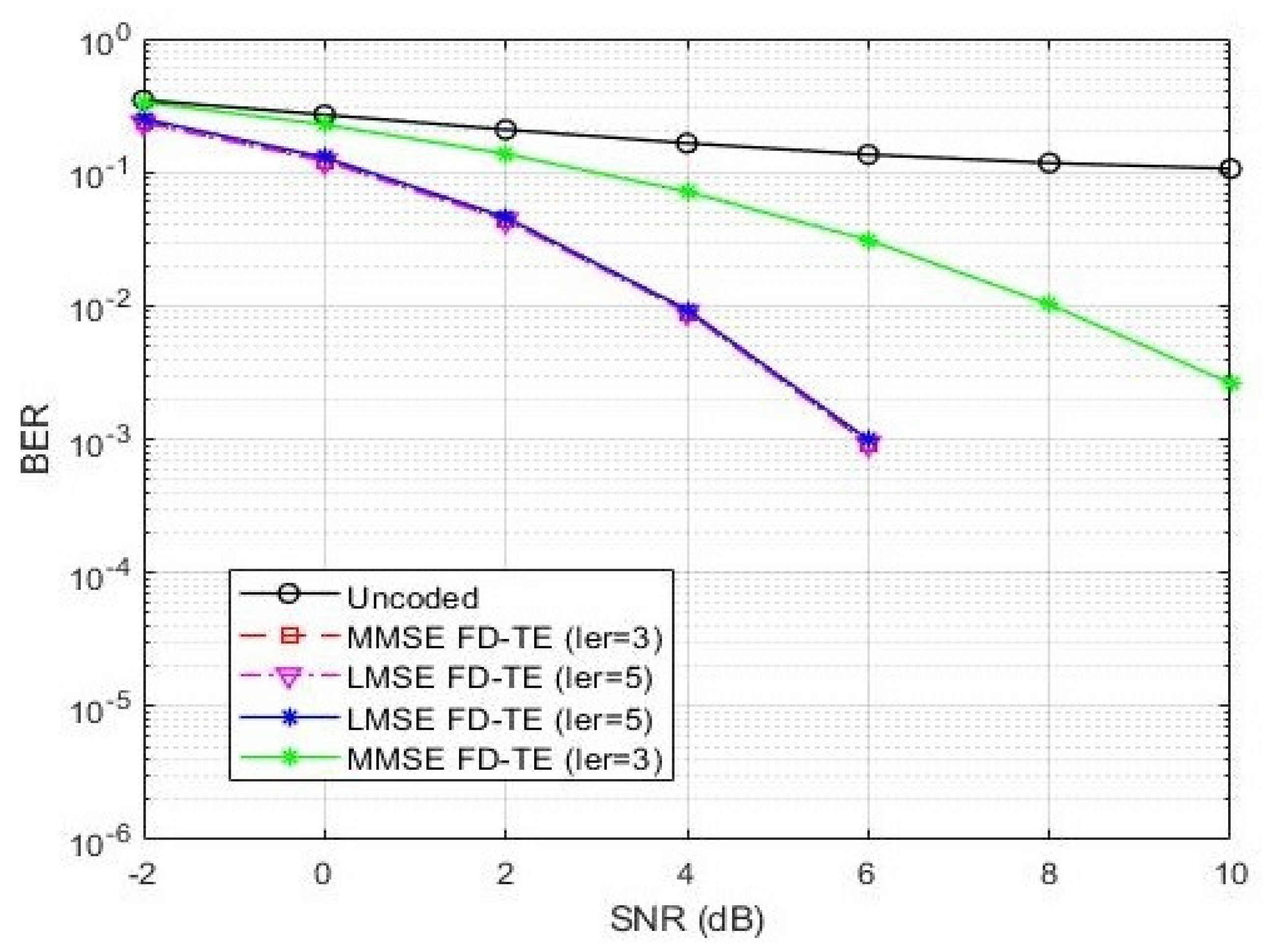An Efficient Turbo Decoding and Frequency Domain Turbo Equalization for LTE Based Narrowband Internet of Things (NB-IoT) Systems
Abstract
:1. Introduction
2. System Model
2.1. MAP Turbo Decoding
2.2. Frequency Domain Turbo Equalization
3. Numerical Results and Complexity Analysis
3.1. Simulation Setup
3.2. BER Performance
3.3. Complexity Analysis
4. Conclusions and Future Work
Author Contributions
Funding
Institutional Review Board Statement
Informed Consent Statement
Data Availability Statement
Conflicts of Interest
References
- Da Xu, L.; He, W.; Li, S. Internet of Things in industries: A survey. IEEE Trans. Ind. Informat. 2014, 10, 2233–2243. [Google Scholar]
- Femminella, M.; Pergolesi, M.; Reali, G. 5G experiment design through Blueprint. Comput. Netw. 2021, 190, 107948. [Google Scholar] [CrossRef]
- Rastogi, E.; Saxena, N.; Roy, A.; Shin, D.R. Narrowband Internet of Things: A Comprehensive Study. Comput. Netw. 2020, 173, 107209. [Google Scholar] [CrossRef]
- Migabo, E.M.; Djouani, K.D.; Kurien, A.M. The Narrowband Internet of Things (NB-IoT) Resources Management Performance State of Art, Challenges, and Opportunities. IEEE Access 2020, 8, 97658–97675. [Google Scholar] [CrossRef]
- Mikhaylov, K.; Petrov, V.; Gupta, R.; Lema, M.A.; Galinina, O.; Andreev, S.; Koucheryavy, Y.; Valkama, M.; Pouttu, A.; Dohler, M. Energy Efficiency of Multi-Radio Massive Machine-Type Communication (MR-MMTC): Applications, Challenges, and Solutions. IEEE Commun. Mag. 2019, 57, 100–106. [Google Scholar] [CrossRef]
- Stusek, M.; Masek, P.; Sedova, J.; Hosek, J. IoT Protocols for Low-power Massive IoT: A Communication Perspective. In Proceedings of the 2019 11th International Congress on Ultra Modern Telecommunications and Control Systems and Workshops (ICUMT), Dublin, Ireland, 28–30 October 2019; pp. 1–7. [Google Scholar]
- Zhou, F.; Li, L. Pondering over the operation status and security issue of NB-IoT. Procedia Comput. Sci. 2021, 183, 18–22. [Google Scholar] [CrossRef]
- Bocker, S.; Arendt, C.; Jorke, P.; Wietfeld, C. LPWAN in the Context of 5G: Capability of LoRaWAN to Contribute to mMTC. In Proceedings of the 2019 IEEE 5th World Forum on Internet of Things (WF-IoT), Limerick, Ireland, 15–18 April 2019; pp. 737–742. [Google Scholar]
- Costa, M.; Farrell, T.; Doyle, L. On energy efficiency and lifetime in low power wide area network for the Internet of Things. In Proceedings of the 2017 IEEE Conference on Standards for Communications and Networking (CSCN), Helsinki, Finland, 18–20 September 2017; pp. 258–263. [Google Scholar]
- Zhang, X.; Zhang, M.; Meng, F.; Qiao, Y.; Xu, S.; Hour, S. A low-power wide-area network information monitoring system by combining NB-IoT and LoRa. IEEE Internet Things J. 2019, 6, 590–598. [Google Scholar] [CrossRef]
- Onumanyi, A.J.; Abu-Mahfouz, A.M.; Hancke, G.P. Cognitive radio in low power wide area network for IoT applications: Recent approaches, benefits and challenges. IEEE Trans. Ind. Inf. 2019, 16, 7489–7498. [Google Scholar] [CrossRef]
- Zakariyya, R.S.; Jewel, K.H.; Fadamiro, A.O.; Famoriji, O.J.; Lin, F. An Efficient Polar Coding Scheme for Uplink Data Transmission in Narrowband Internet of Things Systems. IEEE Access 2020, 8, 191472–191481. [Google Scholar] [CrossRef]
- Kanj, M.; Savaux, V.; le Guen, M. A tutorial on nb-iot physical layer design. IEEE Commun. Surv. Tutor. 2020, 22, 2408–2446. [Google Scholar] [CrossRef]
- Goudos, S.K.; Deruyck, M.; Plets, D.; Martens, L.; Psannis, K.E.; Sarigiannidis, P.; Joseph, W. A novel design approach for 5G massive MIMO and NB-IoT green networks using a hybrid jaya-differential evolution algorithm. IEEE Access 2019, 7, 105687–105700. [Google Scholar] [CrossRef]
- Ferdian, R.; Anwar, K.; Adiono, T. Efficient equalization hardware architecture for SC-FDMA systems without cyclic prefix. In Proceedings of the 2012 International Symposium on Communications and Information Technologies (ISCIT), Gold Coast, Australia, 2–5 October 2012; pp. 936–941. [Google Scholar]
- Gao, X.; Wang, W.; Xia, X.; Au, E.K.S.; You, X. Cyclic prefixed OQAM-OFDM and its application to single-carrier FDMA. IEEE Trans. Commun. 2011, 59, 1467–1480. [Google Scholar]
- Mei, F.; Chen, H.; Lei, Y. Blind Recognition of Forward Error Correction Codes Based on Recurrent Neural Network. Sensors 2021, 21, 3884. [Google Scholar] [CrossRef] [PubMed]
- Chen, J.; Abedi, A. Distributed turbo coding and decoding for wireless sensor networks. IEEE Commun. Lett. 2011, 15, 166–168. [Google Scholar] [CrossRef]
- Gbadamosi, S.A.; Hancke, G.P.; Abu-Mahfouz, A.M. Building upon NB-IoT networks: A roadmap towards 5G new radio Networks. IEEE Access 2020, 8, 188641–188672. [Google Scholar] [CrossRef]
- Zhang, J.; Yang, L.; Hanzo, L. Energy-efficient dynamic resource allocation for opportunistic-relaying-assisted SC-FDMA using Turbo-equalizer-aided soft decode-and-forward. IEEE Trans. Vehic. Tech. 2013, 62, 235–246. [Google Scholar] [CrossRef] [Green Version]
- Laot, C.; Glavieux, A.; Labat, J. Turbo equalization: Adaptive equalization and channel decoding jointly optimized. IEEE J. Sel. Commun. 2001, 19, 1744–1752. [Google Scholar] [CrossRef]
- Wu, J.; Vojcic, B. Partial iterative equalization and channel decoding. In Proceedings of the 2009 IEEE International Conference on Acoustics, Speech and Signal Processing, Taipei, Taiwan, 19–24 April 2009; pp. 2657–2660. [Google Scholar]
- Wu, B.; Niu, K.; Gong, P.; Sun, S. An improved MMSE turbo equalization algorithm in frequency domain. In Proceedings of the 2012 IEEE 14th International Conference on Communication Technology, Chengdu, China, 9–11 November 2012; pp. 444–448. [Google Scholar]
- 3rd Generation Partnership Project; Technical Specification Group Services and System Aspects; Study on Cellular Internet of Things (IoT) Support and Evolution for the 5G System (Release 16), Version 16.0.0; Document 3GPP 23.724. Available online: https://www.3gpp.org/ (accessed on 20 December 2018).
- Yang, L.; Xie, Y.; Wu, X.; Yuan, J.; Cheng, X.; Wan, L. Partially information-coupled turbo codes for LTE systems. IEEE Trans. Commun. 2018, 66, 4381–4392. [Google Scholar] [CrossRef]
- Azari, A.; Stefanović, Č.; Popovski, P.; Cavdar, C. On the latency-energy performance of NB-IoT systems in providing wide-area IoT connectivity. IEEE Trans. Green Commun. Netw. 2020, 4, 57–68. [Google Scholar] [CrossRef]
- The Math Works, Inc. MATLAB, version 2020a ed; The Math Works, Inc.: Natick, MA, USA, 2020; Computer Software; Available online: www.mathworks.com/ (accessed on 12 December 2020).
- Salah, M.M.; Elrahman, A.A. Energy efficiency based concatenated LDPC and turbo codes for wireless sensor networks. In Proceedings of the 2015 IEEE International Conference on Signal Processing, Communications and Computing (ICSPCC), Ningbo, China, 19–22 September 2015; pp. 1–6. [Google Scholar]
- Berrou, C.; Glavieux, A.; Thitimajshima, P. Near Shannon limit error-correcting coding and decoding: Turbo-codes. In Proceedings of the ICC ’93—IEEE International Conference on Communications, Geneva, Switzerland, 23–26 May 1993; Volume 2, pp. 1064–1070. [Google Scholar]









| Technology | LTE-A | EC-GSM | NB-IoT |
|---|---|---|---|
| Deployment | In-band LTE | In-band GSM | In-band, Guard-band, and Stand-alone |
| Bandwidth | 1.08 MHz | 200 kHz per channel. | 180 kHz |
| Network Coverage | 155.7 dB | 164 dB, with 33 dBm power class. 154 dBm, with 23 dBm power class | 164 dB for stand-alone and FFS for others |
| Downlink Technology | OFDMA, with 15 kHz SCS | TDMA, FDMA, GMSK and 8 PSK | OFDM with 15 kHz SCS |
| Uplink Technology | SC-FDMA with 15 kHz SCS | TDMA, FDMA, GMSK and 8 PSK | Single-tone SC-FDMA with both 15 kHz and 3.75 kHz. Multi-tone SC-FDMA with 15 kHz |
| Data Rates | 1 Mbps for both UL and DL | 70 Kbps with TDMA, FDMA for both UL and DL and 240 kbps with 8 PSK | 28 kbps for DL and 63 kbps for UL |
| Duplexing | FD and HD (type B), FDD | HD and FDD | HD (type B) and FDD |
| Power saving | PSM, ext. 1 DRX, C-DRX | PSM, ext. 1-DRX | PSM, ext. 1 DRX, C-DRX |
| Power class | 23 dBm, 20 dBm | 33 dBm, 23 dBm | 23 dBm, other TBD |
Publisher’s Note: MDPI stays neutral with regard to jurisdictional claims in published maps and institutional affiliations. |
© 2021 by the authors. Licensee MDPI, Basel, Switzerland. This article is an open access article distributed under the terms and conditions of the Creative Commons Attribution (CC BY) license (https://creativecommons.org/licenses/by/4.0/).
Share and Cite
Adamu, M.J.; Qiang, L.; Zakariyya, R.S.; Nyatega, C.O.; Kawuwa, H.B.; Younis, A. An Efficient Turbo Decoding and Frequency Domain Turbo Equalization for LTE Based Narrowband Internet of Things (NB-IoT) Systems. Sensors 2021, 21, 5351. https://doi.org/10.3390/s21165351
Adamu MJ, Qiang L, Zakariyya RS, Nyatega CO, Kawuwa HB, Younis A. An Efficient Turbo Decoding and Frequency Domain Turbo Equalization for LTE Based Narrowband Internet of Things (NB-IoT) Systems. Sensors. 2021; 21(16):5351. https://doi.org/10.3390/s21165351
Chicago/Turabian StyleAdamu, Mohammed Jajere, Li Qiang, Rabiu Sale Zakariyya, Charles Okanda Nyatega, Halima Bello Kawuwa, and Ayesha Younis. 2021. "An Efficient Turbo Decoding and Frequency Domain Turbo Equalization for LTE Based Narrowband Internet of Things (NB-IoT) Systems" Sensors 21, no. 16: 5351. https://doi.org/10.3390/s21165351
APA StyleAdamu, M. J., Qiang, L., Zakariyya, R. S., Nyatega, C. O., Kawuwa, H. B., & Younis, A. (2021). An Efficient Turbo Decoding and Frequency Domain Turbo Equalization for LTE Based Narrowband Internet of Things (NB-IoT) Systems. Sensors, 21(16), 5351. https://doi.org/10.3390/s21165351









